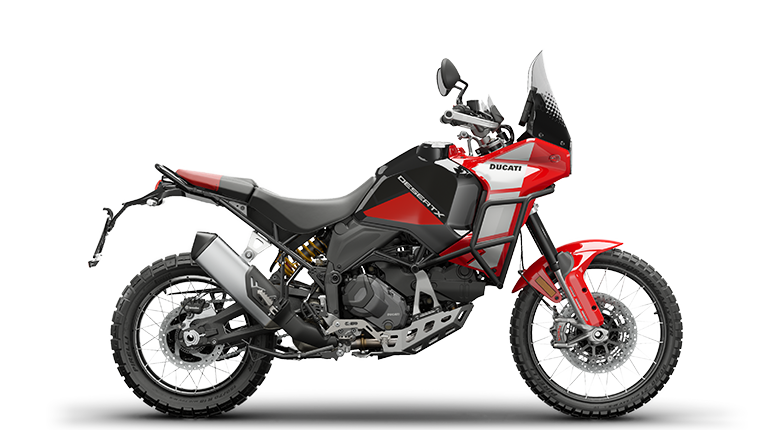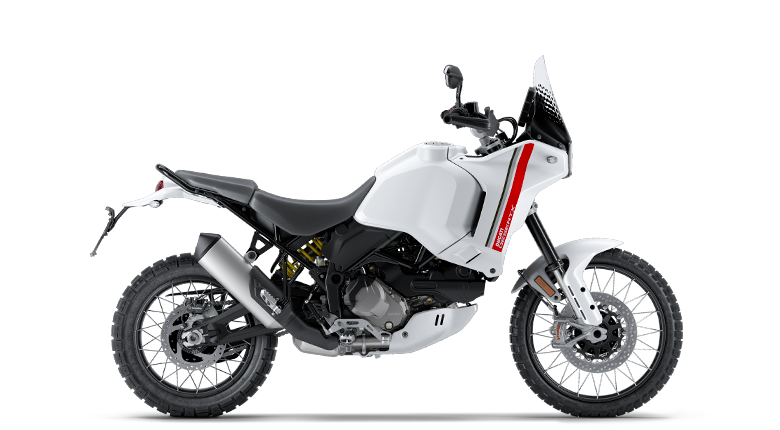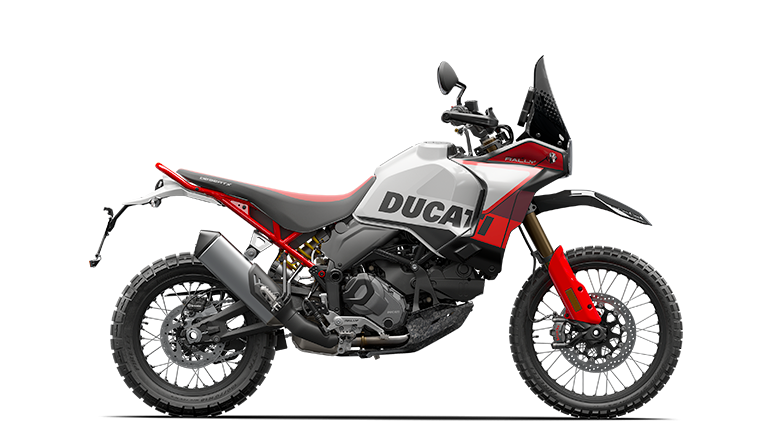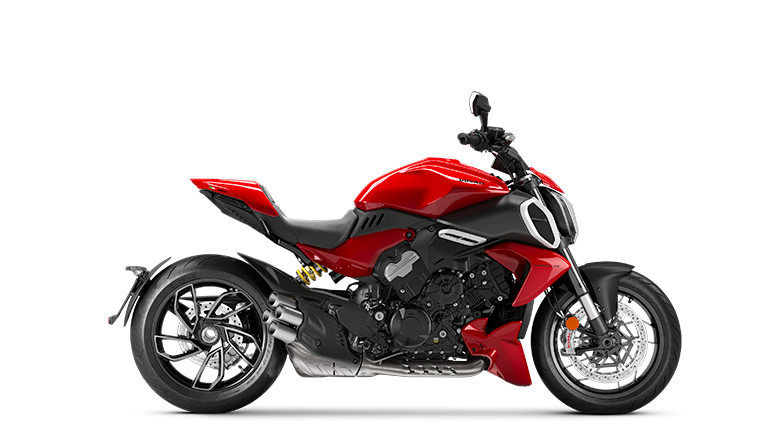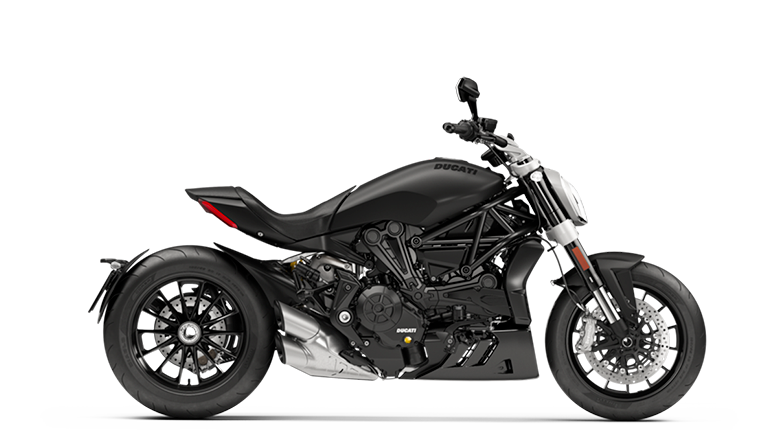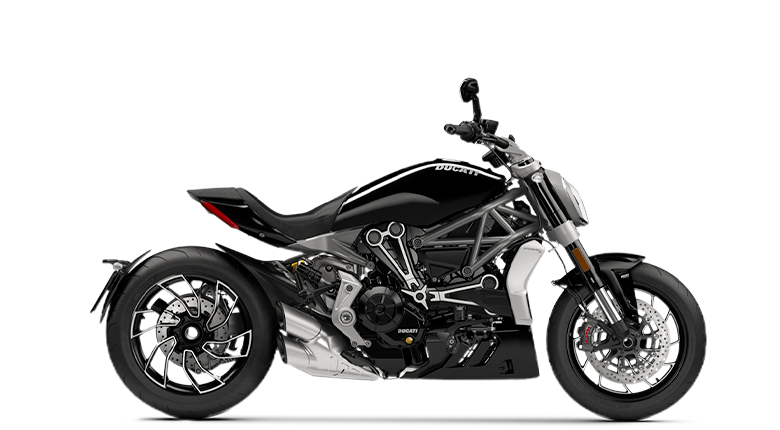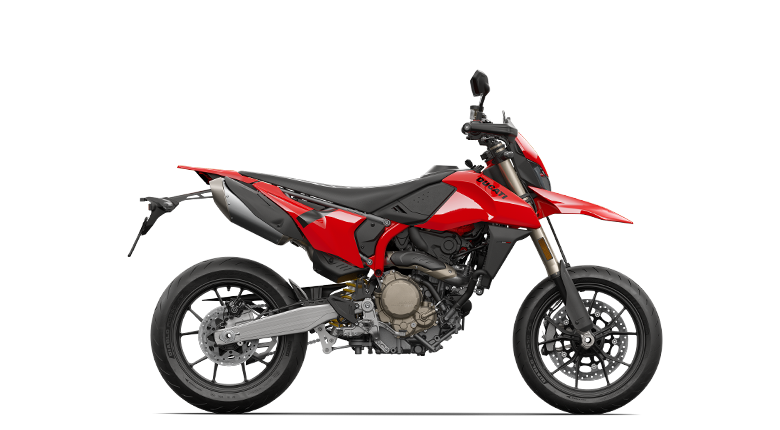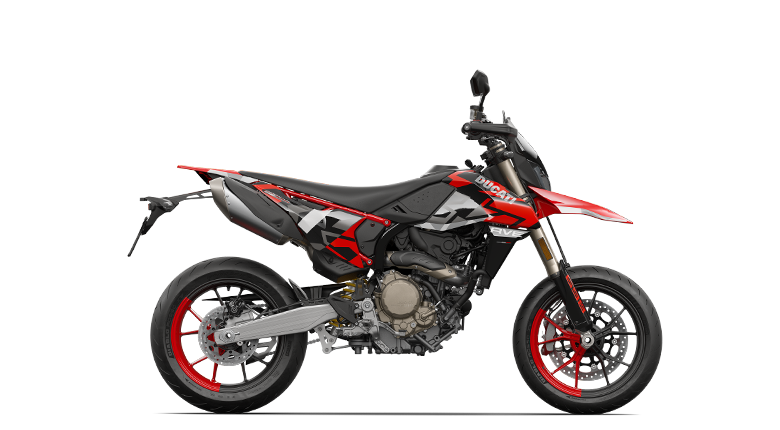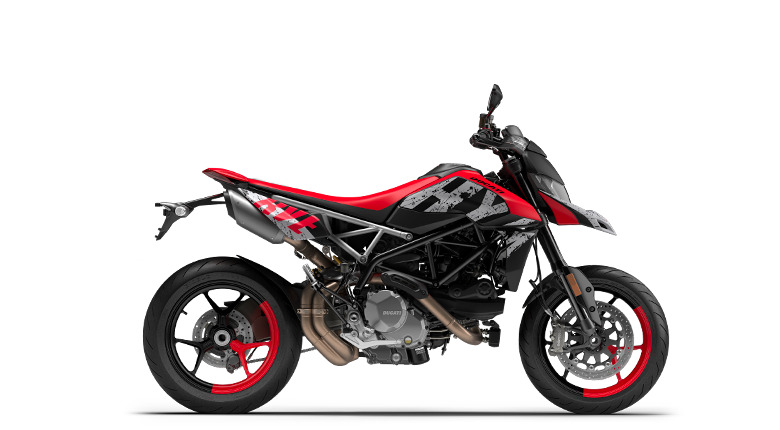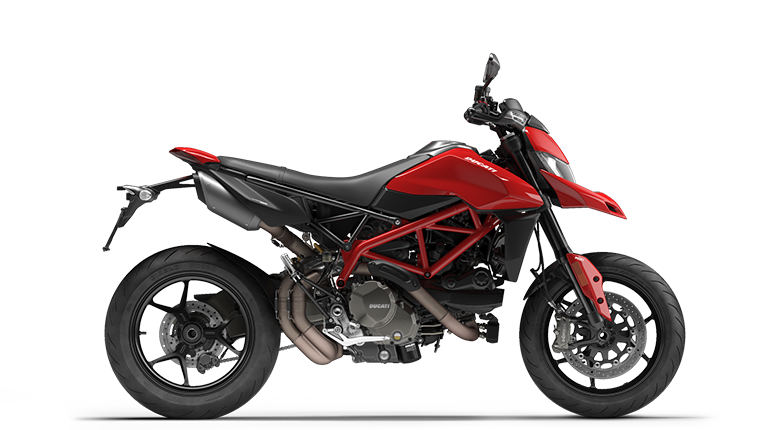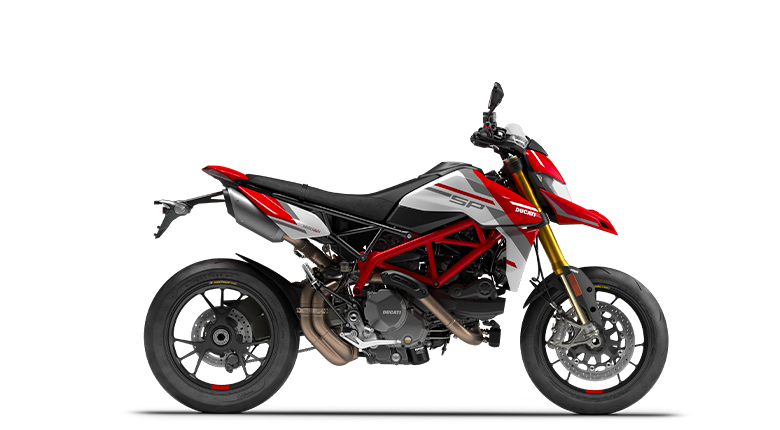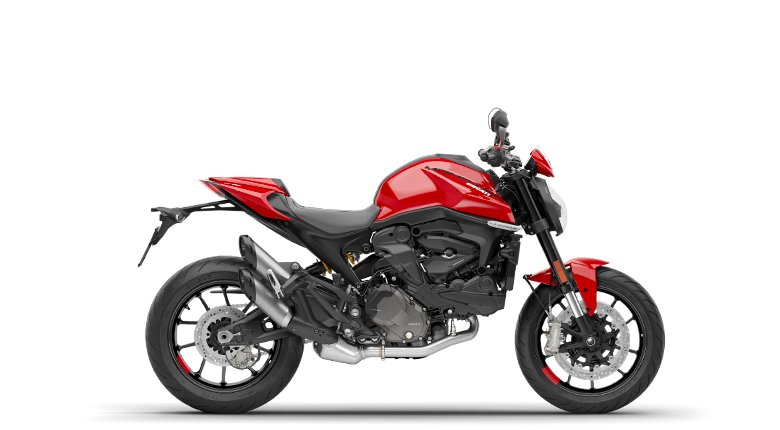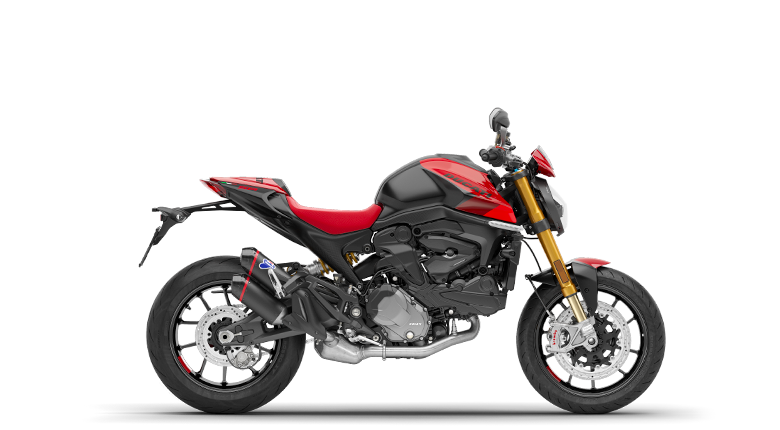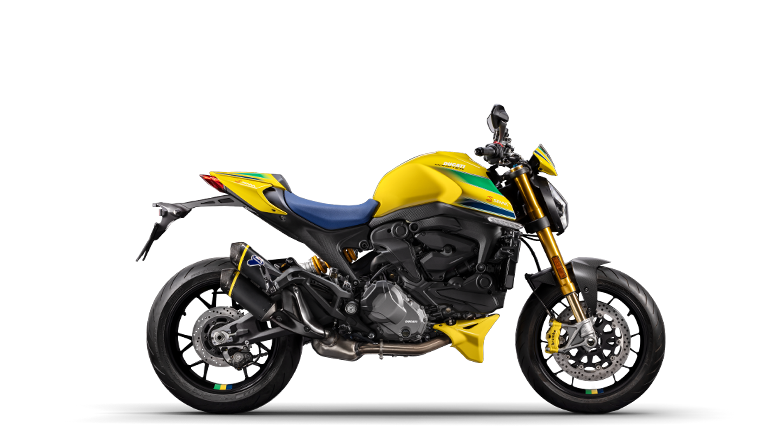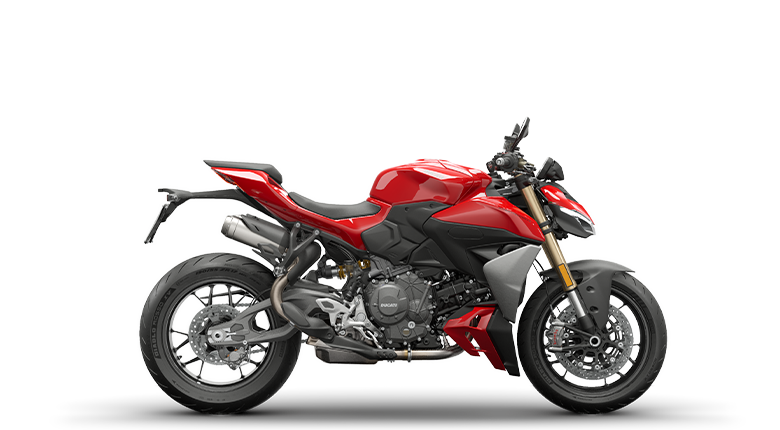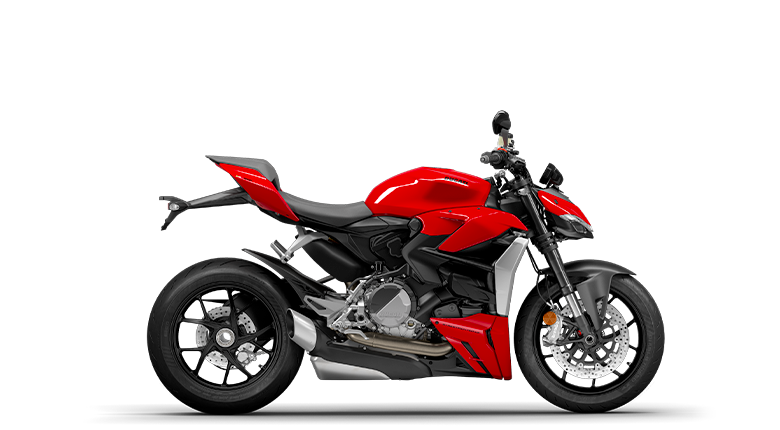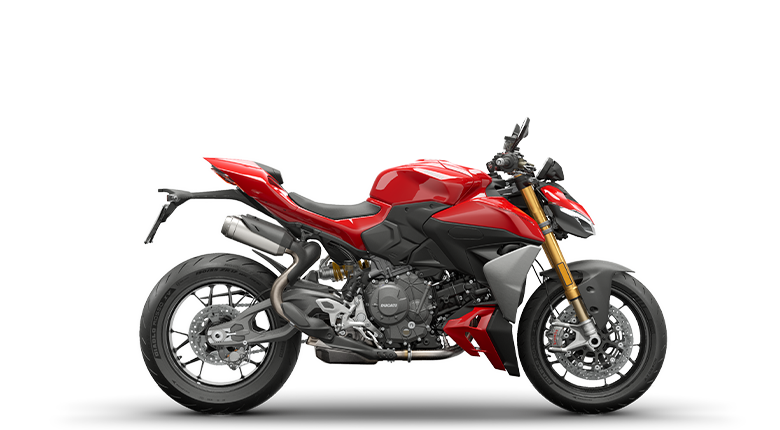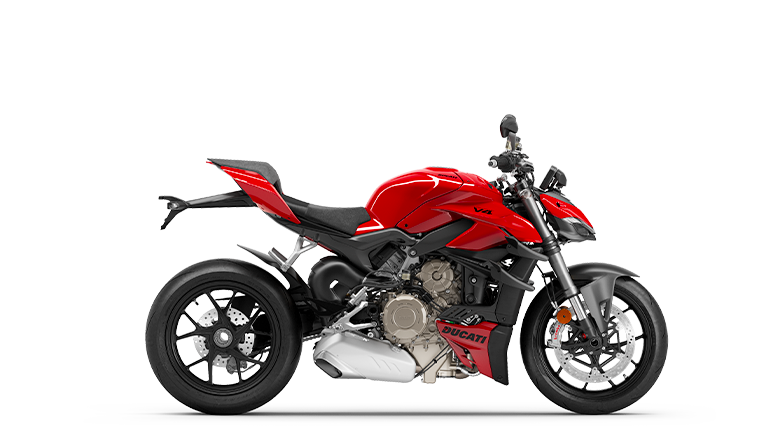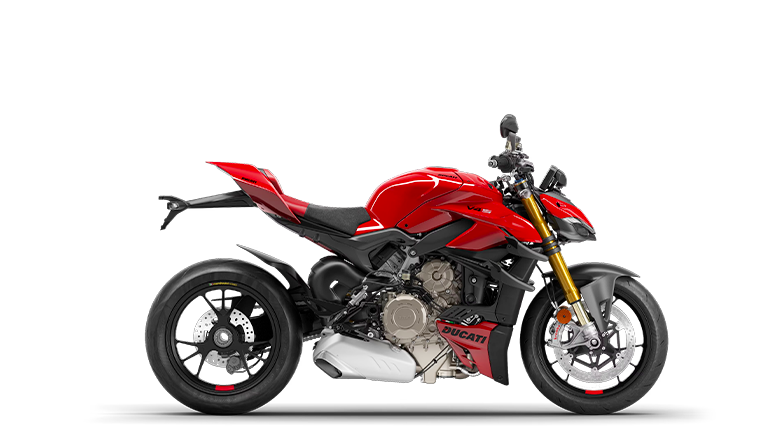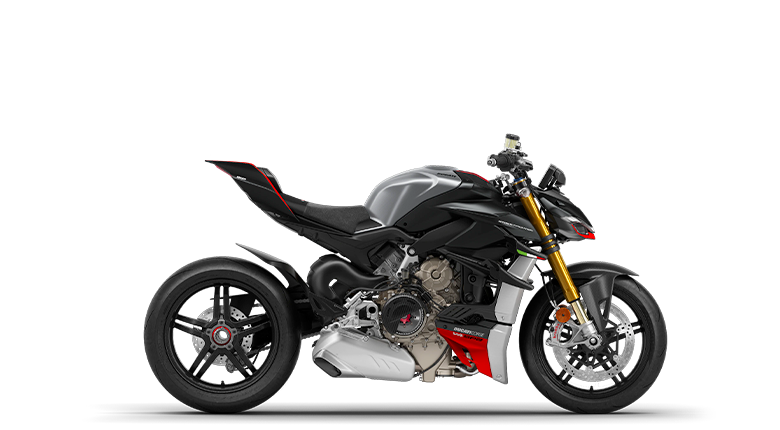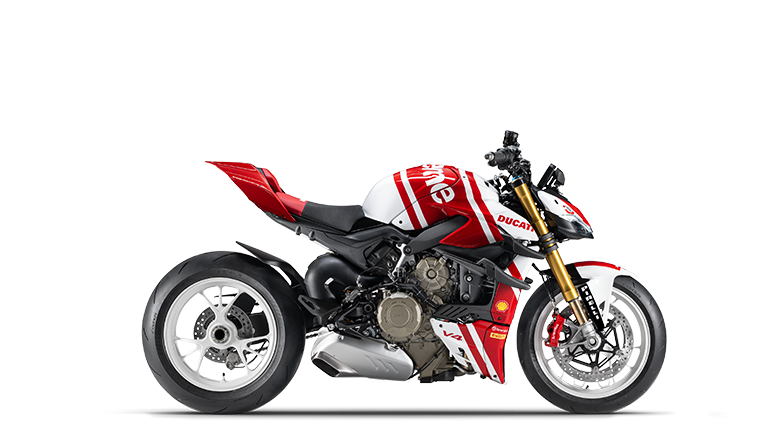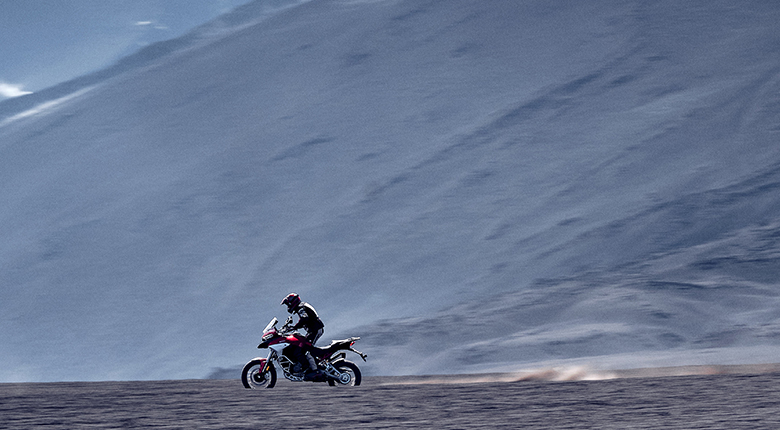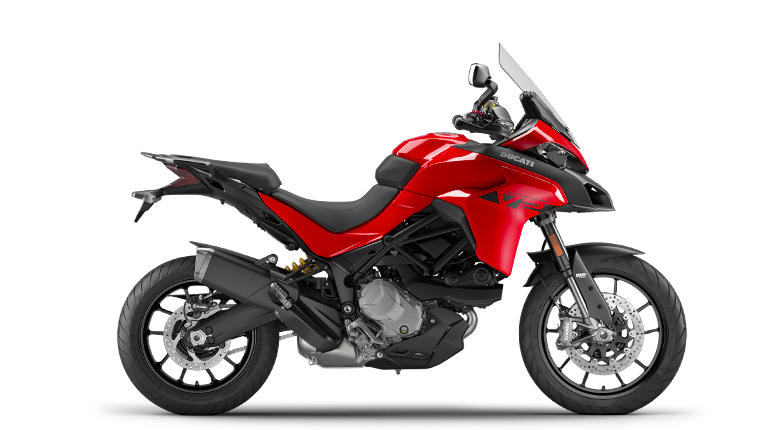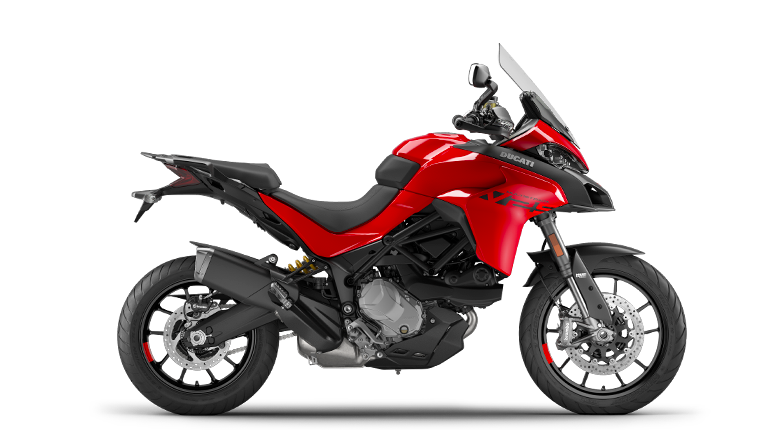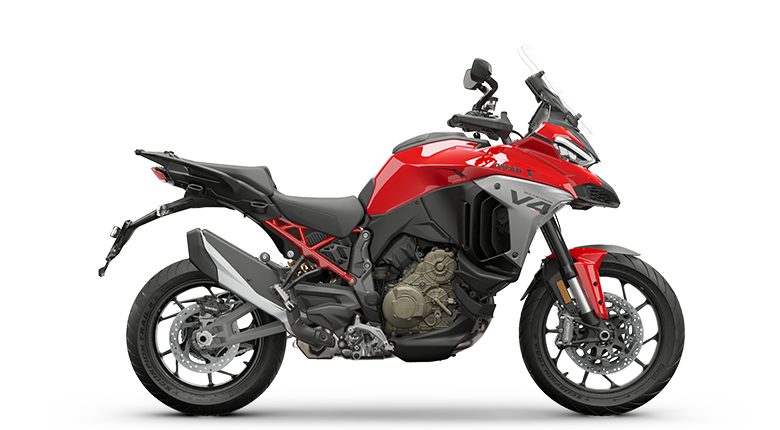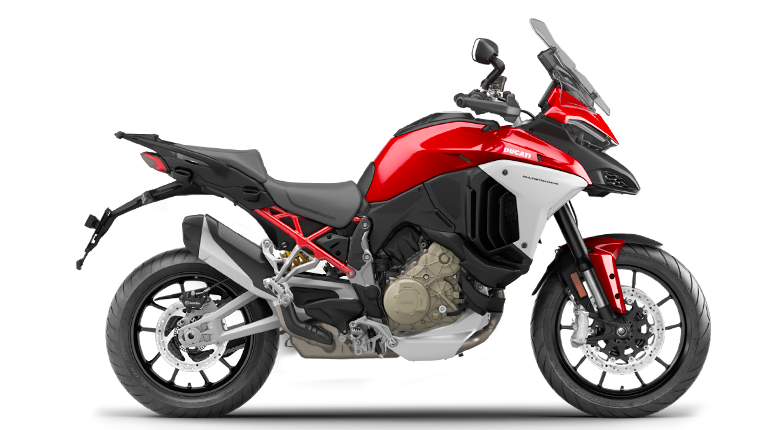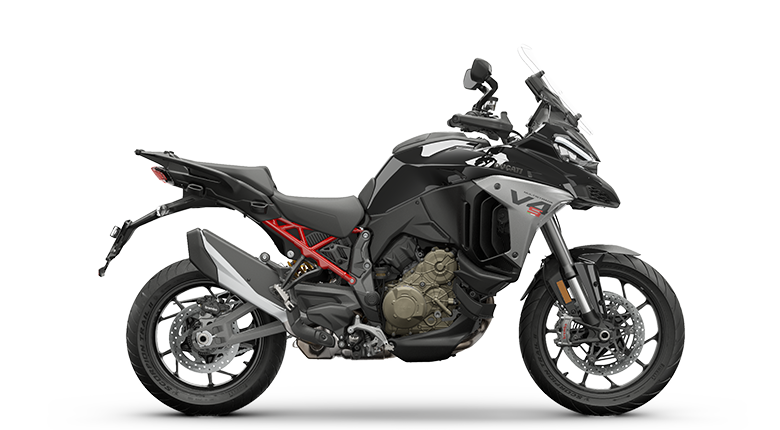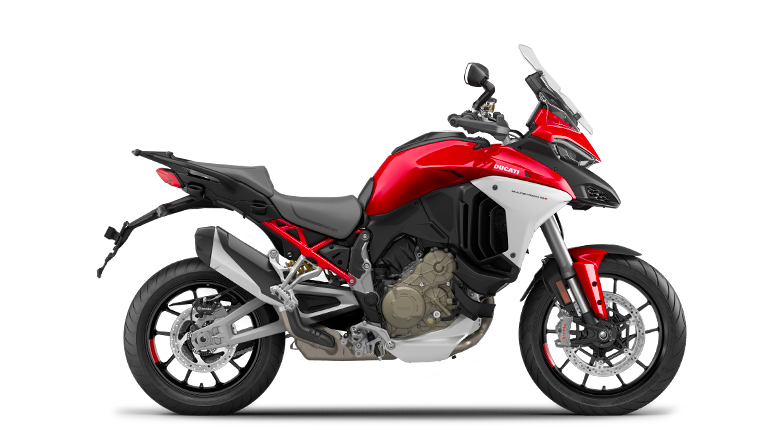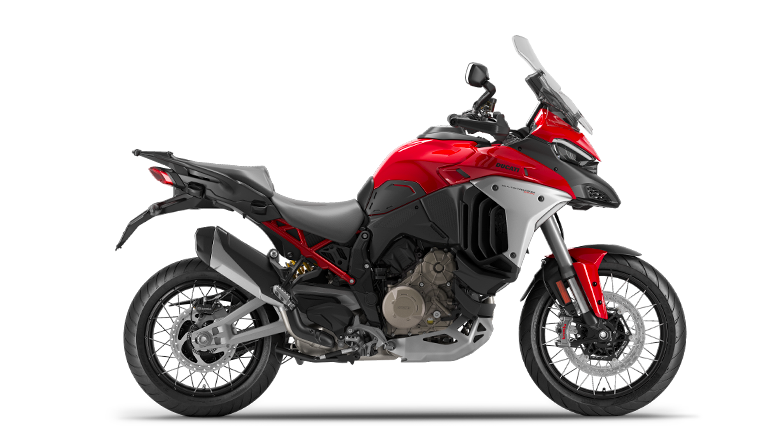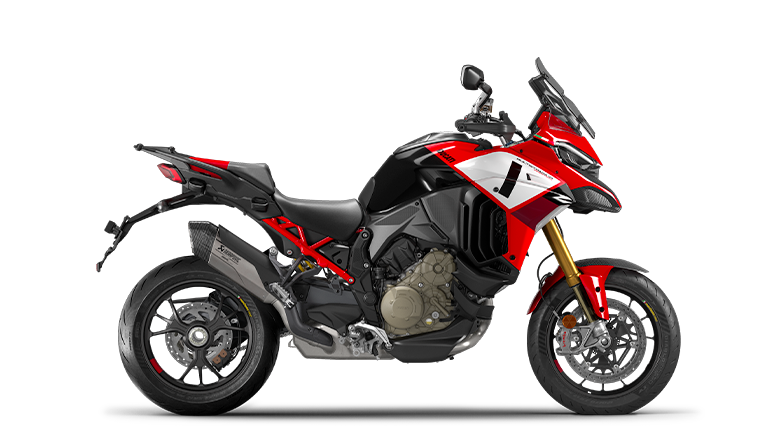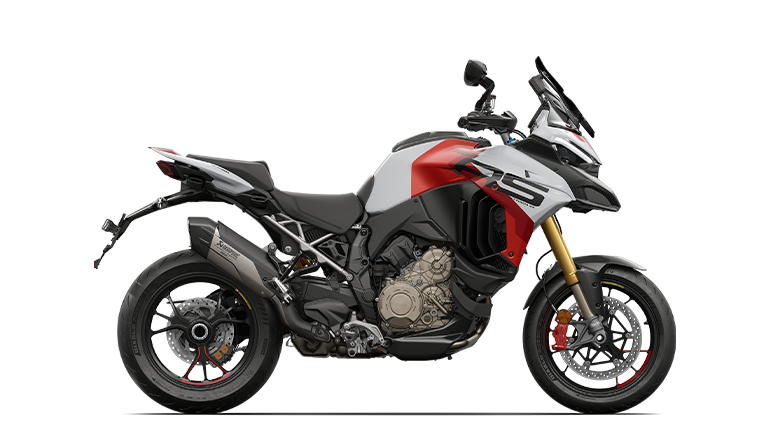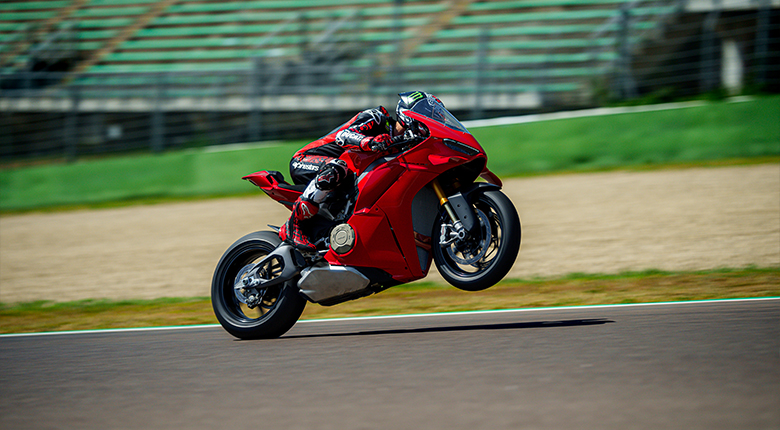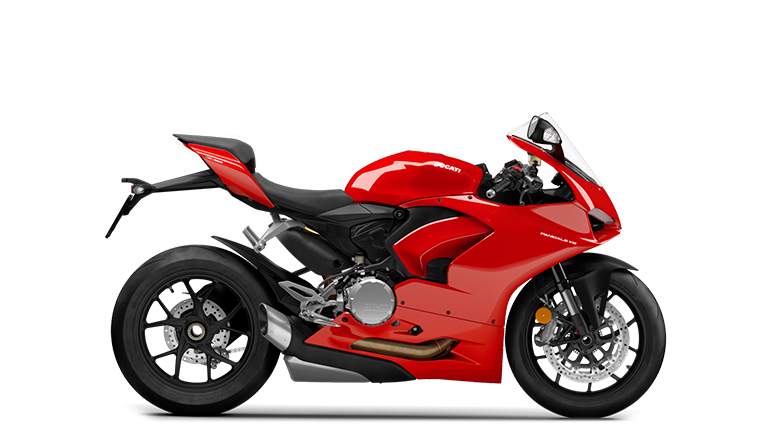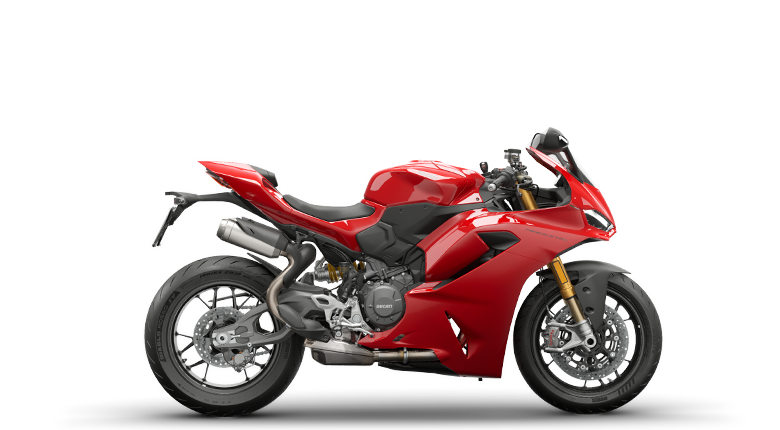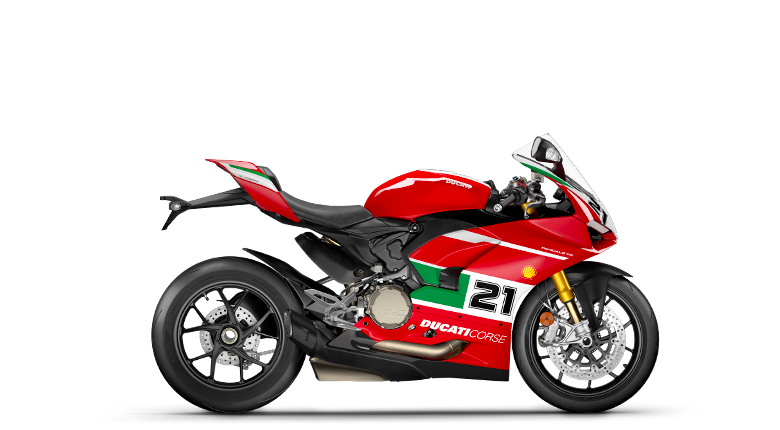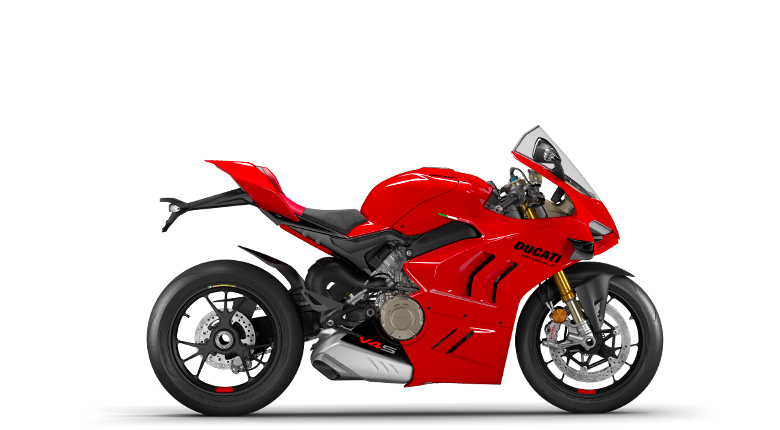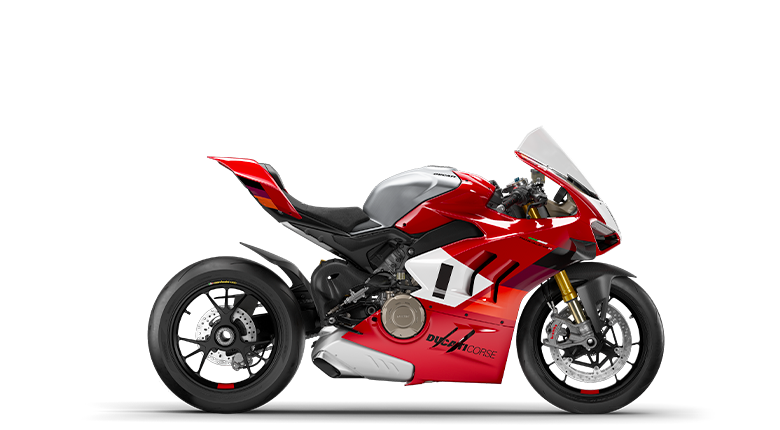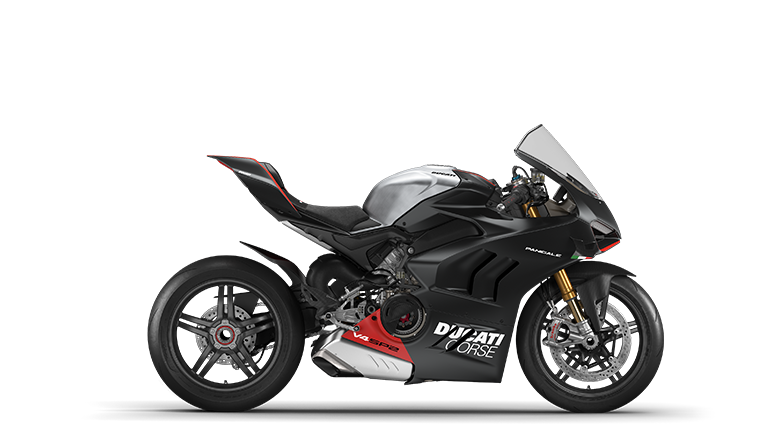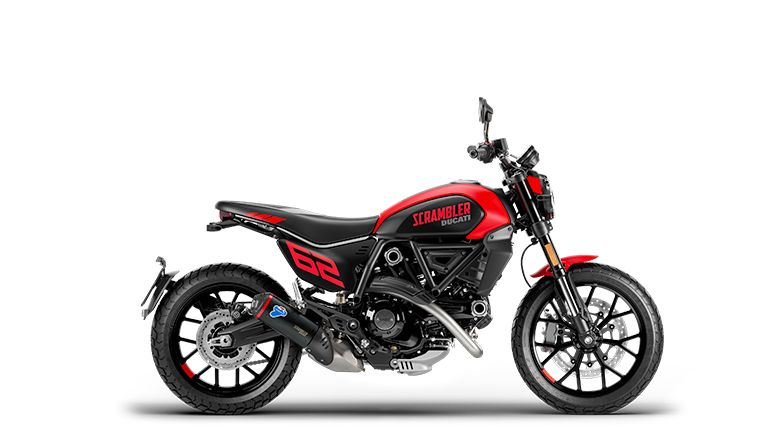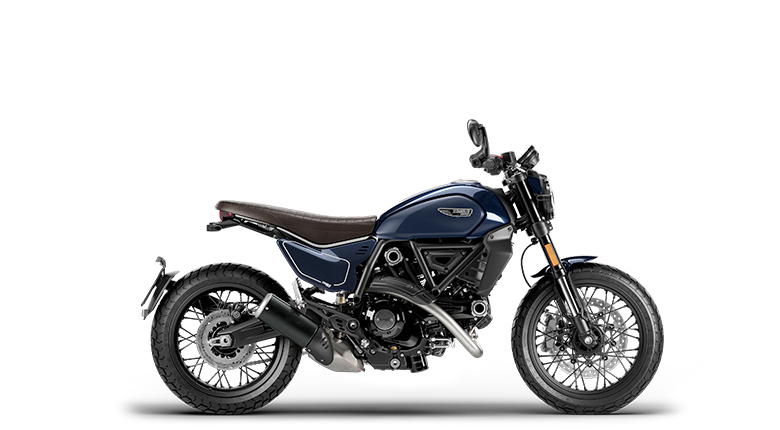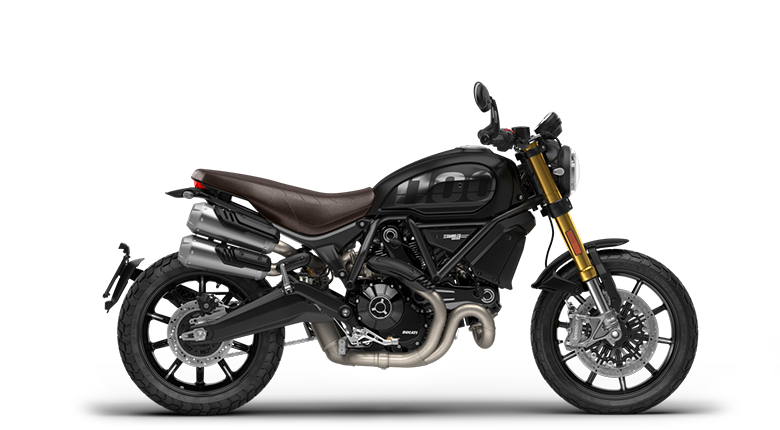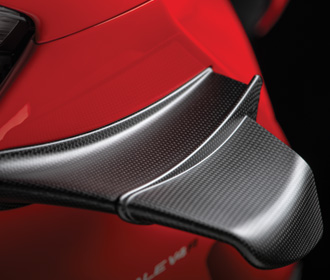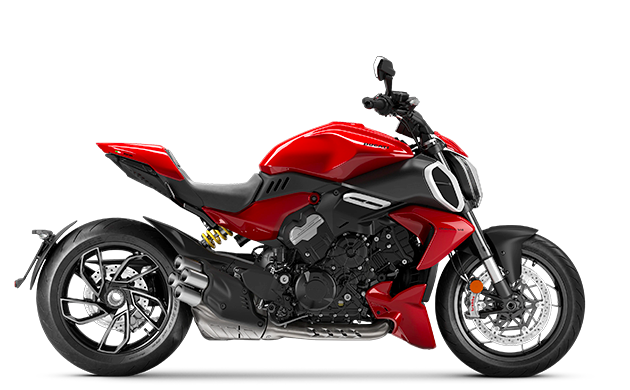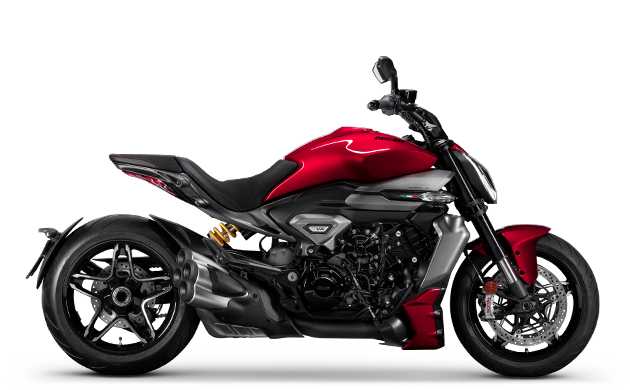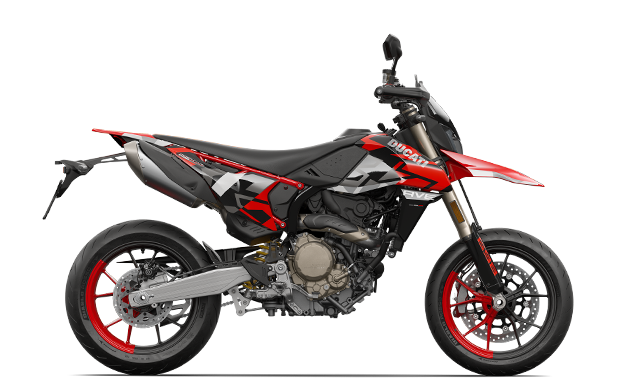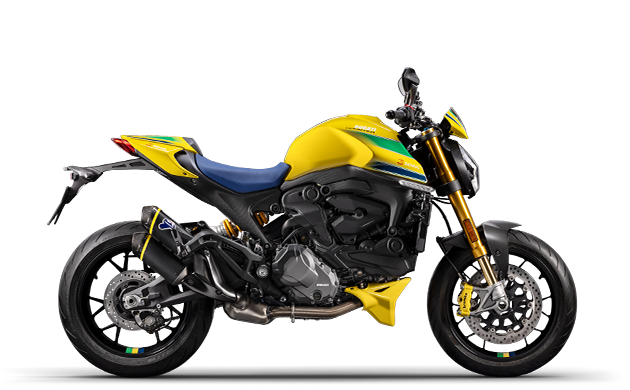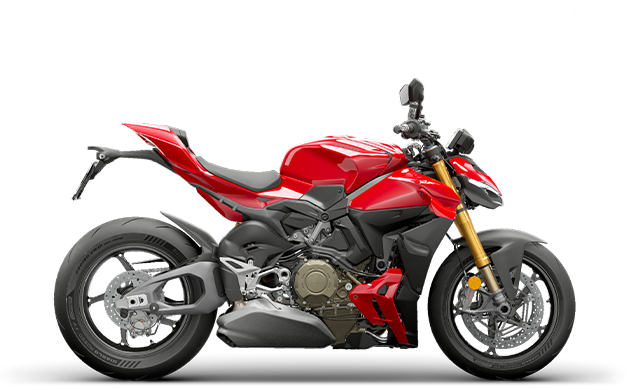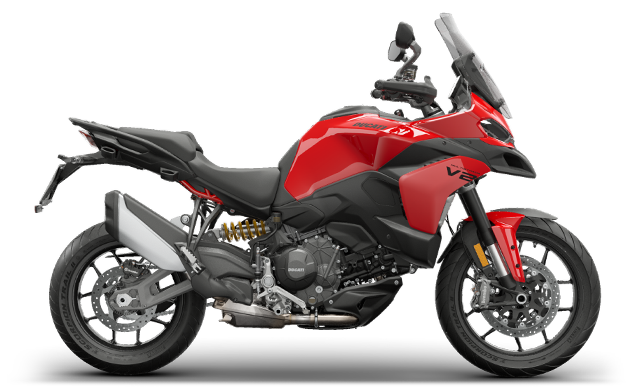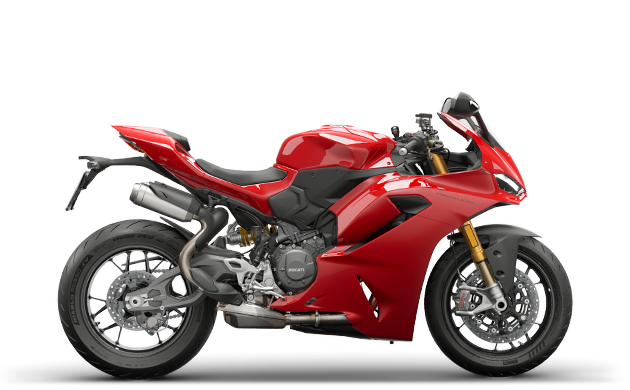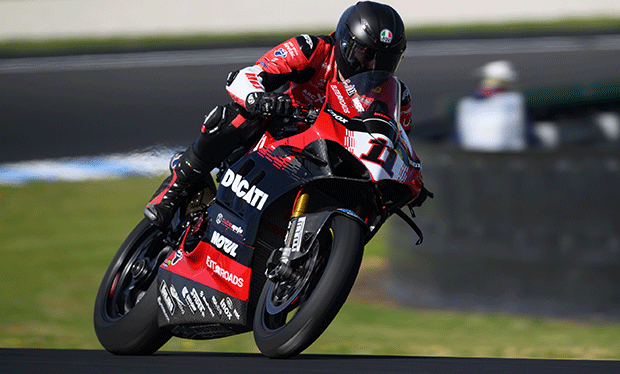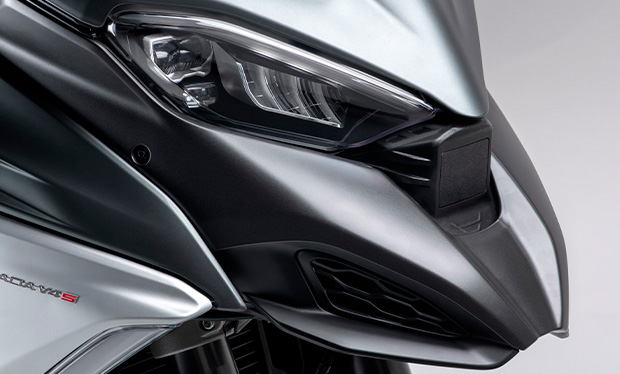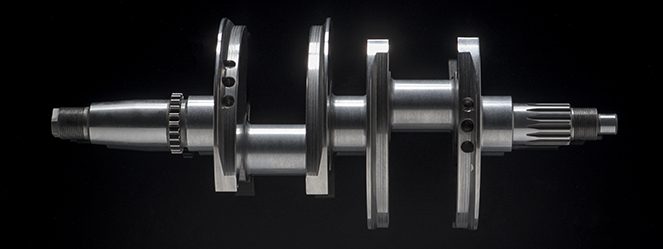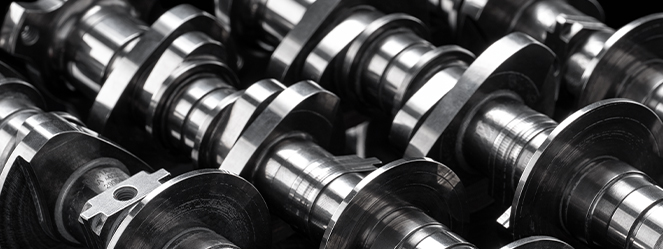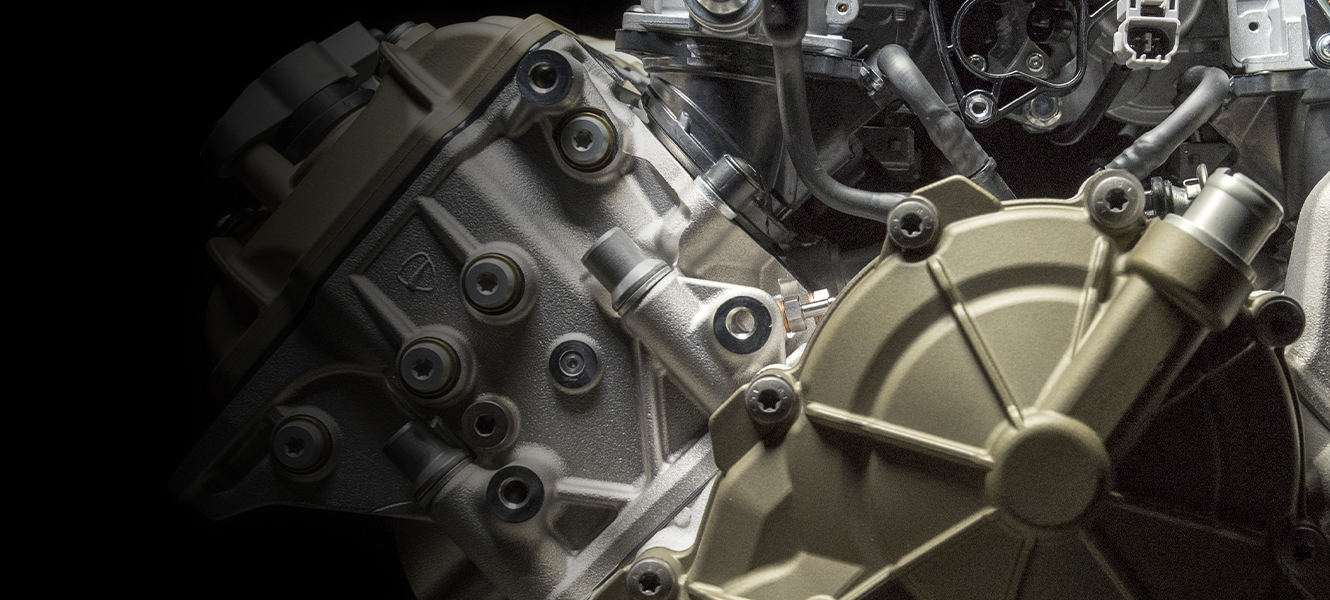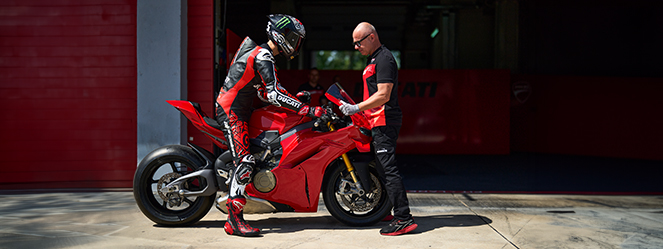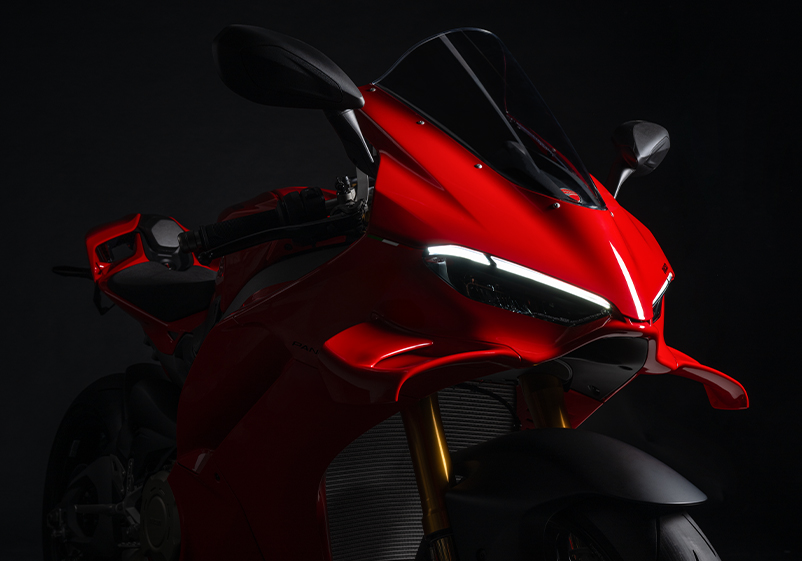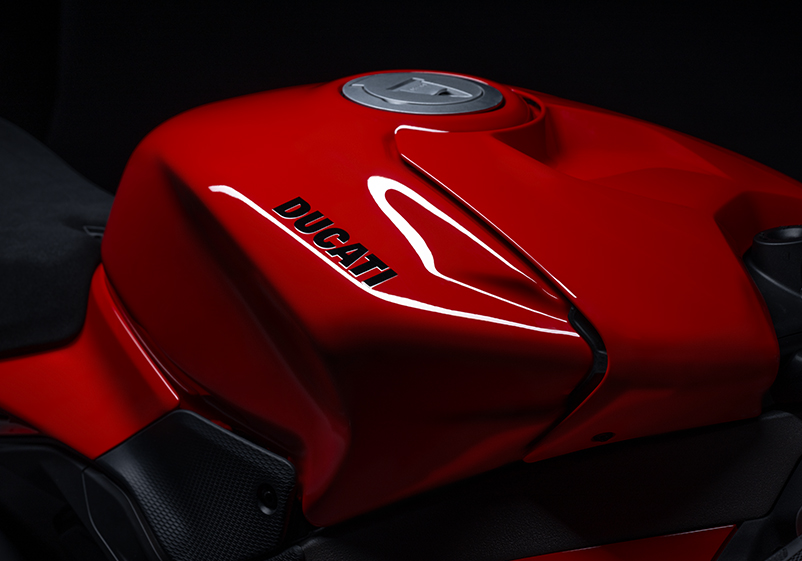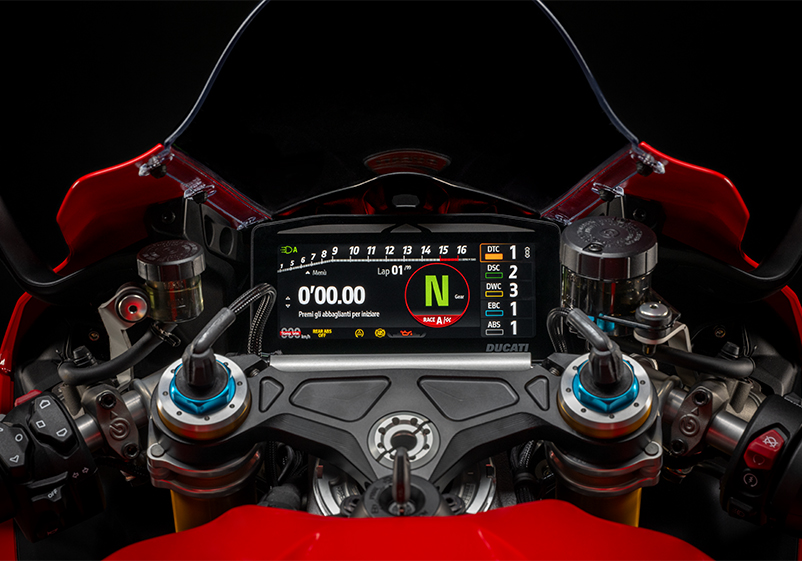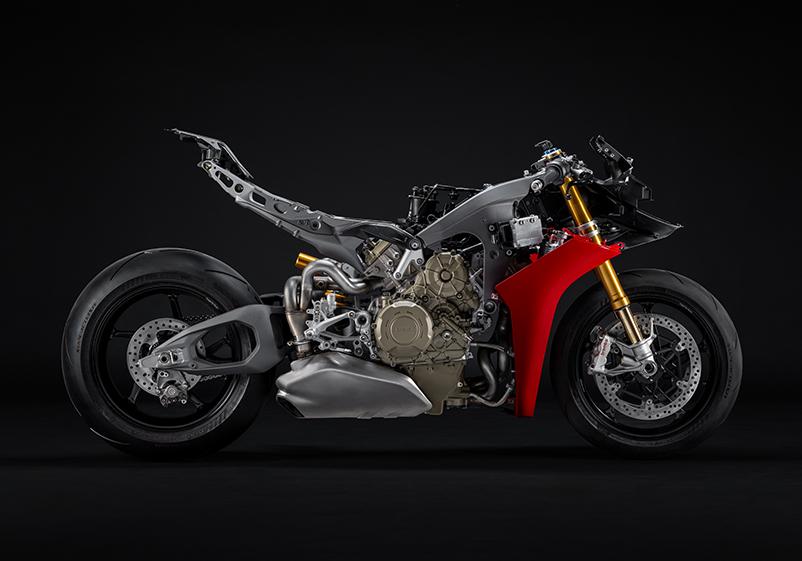The Panigale V4 mounts the 1003 cc Desmosedici Stradale: the 90° V4 (rotated backwards by 42°) with MotoGP-derived Desmodromic timing, unique in terms of its counter-rotating crankshaft and “Twin Pulse” firing order.
Engine
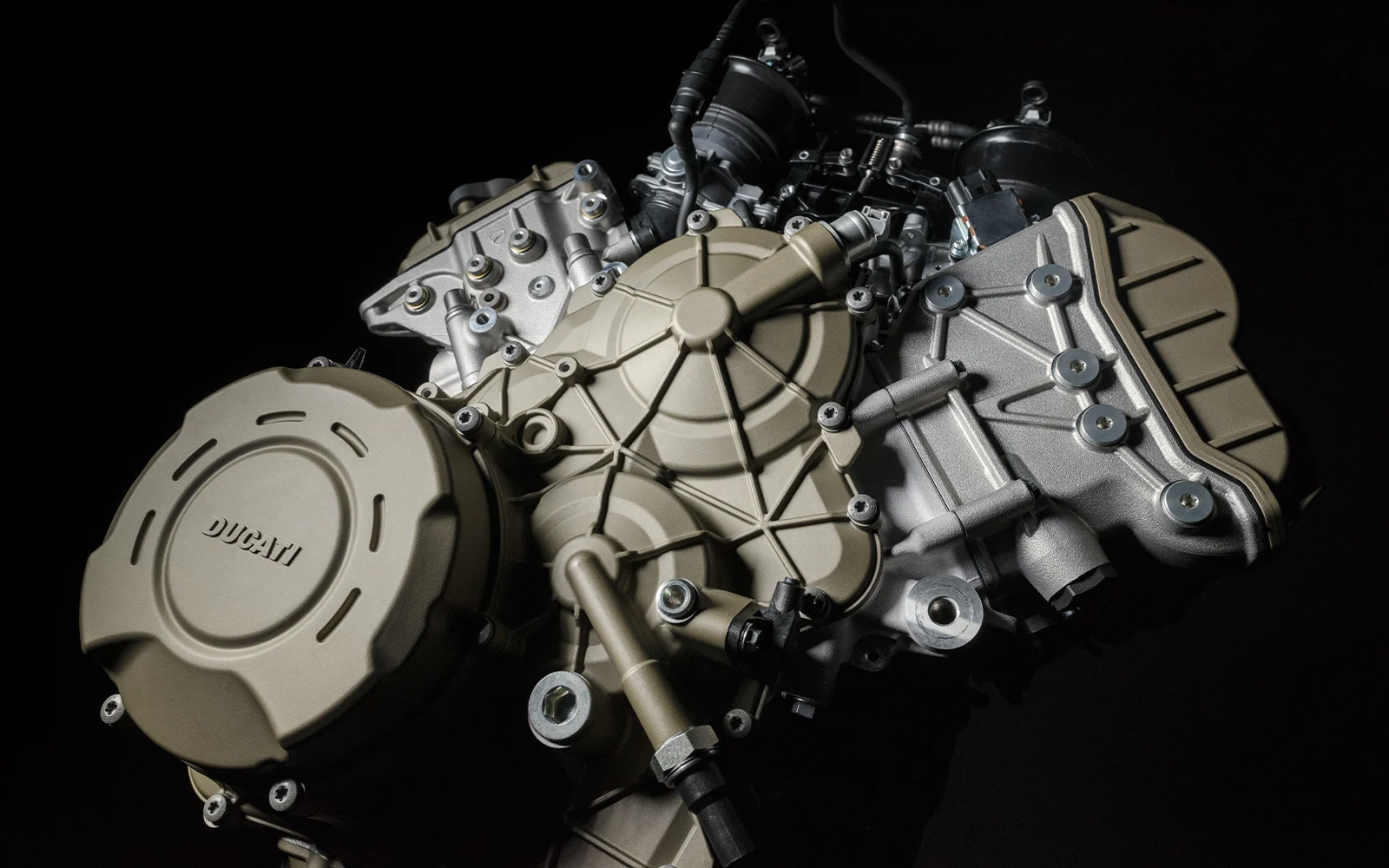
- 1103 cc Desmosedici Stradale V4
-
![]() Read more in the Engines section
Read more in the Engines section
- Twin Pulse firing order
-
![]()
Crank pins offset by 70° combined with the 90° V layout of the engine result in a firing order that Ducati calls “Twin Pulse”, because it is as if the engine were reproducing the firing sequence of a twin. The distinctiveness lies in the fact that the two left-hand cylinders fire closely together, as do the two right-hand ones. On the timing chart, the ignition points are at 0°, 90°, 290° and 380°. This particular firing order makes the V4 sound very similar to the MotoGP Desmosedici.
- Latest-generation Desmodromic system
-
The Desmosedici Stradale is designed around the Desmodromic system, essential in terms of performance. The four camshafts move the sixteen steel valves, the intake valves measuring 34 mm in diameter and the exhaust valves measuring 27.5 mm, impressive values if related to the 81 mm bore. The valve seats are made of sintered steel. Considering the high engine speeds of the V4 and the significant size of the valves, these would not be able to follow the aggressive cam closing profiles if a spring system were used. This is why the Desmodromic system is indispensable.
- Euro 5+ type approval
-
The Desmosedici Stradale engine now conforms with the strict Euro 5+ standard, recording a slight maximum power increase equating to 0.5 hp, thanks to the use of lighter components that also reduce engine weight by 1 kg.
The Desmosedici Stradale Euro 5+ delivers maximum power of 216 hp at 13,500 rpm and torque of 120.9 Nm at 11,250 rpm.
To maintain the unique style imprint of the under-engine silencers, the exhaust system, in a 4-2-1-2 configuration, has been redesigned in terms of both its manifolds and silencer.
The engine development work has also served to reduce the level of emissions (CO2 151 g/km) and consumption (6.5 l/100km).
- 90° V4: the race engine par excellence
-
For Ducati, the 90° V4 is the ultimate expression of sports attitude for a motorcycle engine. It is no coincidence then that MotoGP Desmosedici engines adopt the same solution. The 90° V-shaped layout of the cylinders creates a natural balance of the primary forces, with no need for a countershaft, which would impact negatively on the weight and power absorption, to eliminate vibration. An extremely important benefit in terms of the reliability and mechanical efficiency of an engine that reaches engine speeds in excess of 14,000 rpm.
- More efficient cooling system
-
The cooling system has been redesigned to guarantee consistent performance even in very high temperatures or extreme use on track. The effective cooling area of the water radiator has been increased by 17%, while the oil radiator benefits from a more efficient, race-derived water circulation layout that is dual flow. The new radiators make for an air mass cooling increase of 19% for the oil radiator and 9% for the water radiator.
- Counter-rotating crankshaft
-
![]()
As on the MotoGP prototypes, the crankshaft is counter-rotating, which means it rotates in the opposite direction to the wheels, to compensate for the gyroscopic effect and ensure handling and agility in the changes of direction, as well as reducing the tendency to wheelie during acceleration and overturn when braking.
- New camshafts
-
![]()
As for maximum power, the new camshafts have higher lift (+ 0.75 mm for the intake cam and + 0.45 mm for the exhaust cam) and are also lighter thanks to larger lightening holes and narrower toothed drive wheels. The lengths of the variable-height intake ducts have been modified to match intake to the new lifts; the long-duct configuration is increased by 5 mm, while the short-duct configuration is reduced by 10 mm.
Tech Spec

- Displacement
- 1,103 cc
- Power
- 158.9 kW (216 hp) @ 13,500 rpm
- Torque
- 120.9 Nm (89.2 lb-ft) @ 11,250 rpm
- Wet weight no fuel
- 191 kg (421 lb)
- Seat Height
- 850 mm (33.5 in)
- Type
-
Desmosedici Stradale 90° V4, counter-rotating crankshaft, Desmodromic timing, 4 valves per cylinder, liquid-cooledDesmosedici Stradale 90° V4, counter-rotating crankshaft, Desmodromic timing, 4 valves per cylinder, liquid-cooled
- Displacement
-
1,103 cc1,103 cc
- Bore x Stroke
-
81 x 53.5 mm81 x 53.5 mm
- Compression Ratio
-
14.0:114.0:1
- Power
-
158.9 kW (216 hp) @ 13,500 rpm158.9 kW (216 hp) @ 13,500 rpm
- Torque
-
120.9 Nm (89.2 lb-ft) @ 11,250 rpm120.9 Nm (89.2 lb-ft) @ 11,250 rpm
- Fuel Injection
-
Electronic fuel injection system. Twin injectors per cylinder. Full ride-by-wire elliptical throttle bodies. Variable length intake systemElectronic fuel injection system. Twin injectors per cylinder. Full ride-by-wire elliptical throttle bodies. Variable length intake system
- Exhaust
-
4-2-1-2 system, with 2 catalytic converters and 4 lambda probes4-2-1-2 system, with 2 catalytic converters and 4 lambda probes
- Gearbox
-
6 speed with Ducati Quick Shift (DQS) up/down 2.06 speed with Ducati Quick Shift (DQS) up/down 2.0
- Primary drive
-
Straight cut gears; Ratio 1.80:1Straight cut gears; Ratio 1.80:1
- Ratio
-
1=36/15 2=34/17 3=33/19 4=32/21 5=30/22 6=27/221=36/15 2=34/17 3=33/19 4=32/21 5=30/22 6=27/22
- Final drive
-
Chain 520; Front sprocket 16; Rear sprocket 41Chain 520; Front sprocket 16; Rear sprocket 41
- Clutch
-
Hydraulically controlled slipper and self-servo wet multiplate clutch. Self bleeding master cylinder.Hydraulically controlled slipper and self-servo wet multiplate clutch. Self bleeding master cylinder.
- Frame
-
Aluminium alloy "Front Frame" with optimised stiffnessesAluminium alloy "Front Frame" with optimised stiffnesses
- Front suspension
-
Fully adjustable Showa BPF fork, 43 mm chromed inner tubesÖhlins NPX 25/30 (SV) S-EC 3.0 pressurized 43 mm fully adjustable fork with TiN treatment. Electronic compression and rebound damping adjustment with Öhlins Smart EC 3.0 event-based mode
- Front Wheel
-
5-spokes light alloy 3.50" x 17"5-spokes forged aluminium alloy 3.50" x 17"
- Front Tyre
-
Pirelli Diablo Supercorsa SP-V4 120/70 ZR17Pirelli Diablo Supercorsa SP-V4 120/70 ZR17
- Rear suspension
-
Fully adjustable Sachs unit. Aluminium Hollow Symmetrical SwingarmFully adjustable Öhlins TTX36 (SV) S-EC 3.0 unit. Electronic compression and rebound damping adjustment with Öhlins Smart EC 3.0 event-based mode. Aluminium Hollow Symmetrical Swingarm
- Rear Wheel
-
5-spokes light alloy 6.00” x 17”5-spokes forged aluminium alloy 6.00" x 17"
- Rear Tyre
-
Pirelli Diablo Supercorsa SP-V4 200/60 ZR17Pirelli Diablo Supercorsa SP-V4 200/60 ZR17
- Wheel Travel (Front/Rear)
-
125 mm (4.9 in) - 130 mm (5.1 in)125 mm (4.9 in) - 130 mm (5.1 in)
- Front Brake
-
2 x 330 mm semi-floating discs, radially mounted Brembo Monobloc Hypure® 4-piston calipers with Race eCBS. Self bleeding master cylinder.2 x 330 mm semi-floating discs, radially mounted Brembo Monobloc Hypure® 4-piston calipers with Race eCBS. Self bleeding master cylinder.
- Rear Brake
-
245 mm disc, 2-piston caliper with Race eCBS245 mm disc, 2-piston caliper with Race eCBS
- Instrumentation
-
Digital unit with 6,9" TFT display and Optical Bonding, 1,280 x 480 px resolutionDigital unit with 6,9" TFT display and Optical Bonding - 1,280 x 480 px resolution
- Wet weight no fuel
-
191 kg (421 lb)187 kg (412 lb)
- Seat Height
-
850 mm (33.5 in)850 mm (33.5 in)
- Wheelbase
-
1,485 mm (58.5 in)1,485 mm (58.5 in)
- Rake
-
24°24°
- Trail
-
98 mm (3.86 in)98 mm (3.86 in)
- Fuel Tank Capacity
-
17 l - 4.49 gallon (US)17 l - 4.49 gallon (US)
- Number of Seats
-
Single seat
Two seats, if passenger seat kit accessory is mountedSingle seat
Two seats, if passenger seat kit accessory is mounted
- Safety Equipment
-
Riding Modes, Power Modes, Race eCBS, Ducati Vehicle Observer (DVO), Ducati Traction Control (DTC) DVO, Ducati Wheelie Control (DWC) DVO, Ducati Slide Control (DSC), Engine Brake Control (EBC), Ducati Brake Light (DBL), Chain guardRiding Modes, Power Modes, Race eCBS, Ducati Vehicle Observer (DVO), Ducati Traction Control (DTC) DVO, Ducati Wheelie Control (DWC) DVO, Ducati Slide Control (DSC), Engine Brake Control (EBC), Ducati Brake Light (DBL), Chain guard
- Standard Equipment
-
Ducati Power Launch (DPL) DVO, Ducati Quick Shift (DQS) up/down 2.0, Full LED headlights with Daytime Running Light (DRL), Sachs steering damper, Quick adjustment buttons, Pit Limiter, Auto-off indicatorsDucati Power Launch (DPL) DVO, Ducati Quick Shift (DQS) up/down 2.0, Full LED headlights with Daytime Running Light (DRL), Ducati Electronic Suspension (DES) 3.0 with Öhlins Smart EC 3.0, Lithium-ion battery, Quick adjustment buttons, Pit Limiter, Auto-off indicators, Forged aluminium wheels
- Ready for
-
Ducati Data Logger (DDL), Anti-Theft, Cruise Control, Tyre Pressure Monitoring System (TPMS), USB port*, Ducati Multimedia System (DMS)*, "Turn By Turn" navigator*
*: Please refer to your local dealer for availabilityDucati Data Logger (DDL), Anti-Theft, Cruise Control, Tyre Pressure Monitoring System (TPMS), USB port*, Ducati Multimedia System (DMS)*, "Turn By Turn" navigator*
*: Please refer to your local dealer for availability
- Warranty
-
24 months unlimited mileage24 months unlimited mileage
- Maintenance service intervals
-
12,000 km (7,500 mi) / 12 months12,000 km (7,500 mi) / 12 months
- Valve Clearance Check
-
24,000 km (15,000 mi)24,000 km (15,000 mi)
- Notes
-
Bike specifications and equipment may vary from market to market. Please refer to your local dealer for further informationBike specifications and equipment may vary from market to market. Please refer to your local dealer for further information

- Displacement
- 1,103 cc
- Power
- 158.9 kW (216 hp) @ 13,500 rpm
- Torque
- 120.9 Nm (89.2 lb-ft) @ 11,250 rpm
- Wet weight no fuel
- 187 kg (412 lb)
- Seat Height
- 850 mm (33.5 in)
- Type
-
Desmosedici Stradale 90° V4, counter-rotating crankshaft, Desmodromic timing, 4 valves per cylinder, liquid-cooledDesmosedici Stradale 90° V4, counter-rotating crankshaft, Desmodromic timing, 4 valves per cylinder, liquid-cooled
- Displacement
-
1,103 cc1,103 cc
- Bore x Stroke
-
81 x 53.5 mm81 x 53.5 mm
- Compression Ratio
-
14.0:114.0:1
- Power
-
158.9 kW (216 hp) @ 13,500 rpm158.9 kW (216 hp) @ 13,500 rpm
- Torque
-
120.9 Nm (89.2 lb-ft) @ 11,250 rpm120.9 Nm (89.2 lb-ft) @ 11,250 rpm
- Fuel Injection
-
Electronic fuel injection system. Twin injectors per cylinder. Full ride-by-wire elliptical throttle bodies. Variable length intake systemElectronic fuel injection system. Twin injectors per cylinder. Full ride-by-wire elliptical throttle bodies. Variable length intake system
- Exhaust
-
4-2-1-2 system, with 2 catalytic converters and 4 lambda probes4-2-1-2 system, with 2 catalytic converters and 4 lambda probes
- Gearbox
-
6 speed with Ducati Quick Shift (DQS) up/down 2.06 speed with Ducati Quick Shift (DQS) up/down 2.0
- Primary drive
-
Straight cut gears; Ratio 1.80:1Straight cut gears; Ratio 1.80:1
- Ratio
-
1=36/15 2=34/17 3=33/19 4=32/21 5=30/22 6=27/221=36/15 2=34/17 3=33/19 4=32/21 5=30/22 6=27/22
- Final drive
-
Chain 520; Front sprocket 16; Rear sprocket 41Chain 520; Front sprocket 16; Rear sprocket 41
- Clutch
-
Hydraulically controlled slipper and self-servo wet multiplate clutch. Self bleeding master cylinder.Hydraulically controlled slipper and self-servo wet multiplate clutch. Self bleeding master cylinder.
- Frame
-
Aluminium alloy "Front Frame" with optimised stiffnessesAluminium alloy "Front Frame" with optimised stiffnesses
- Front suspension
-
Fully adjustable Showa BPF fork, 43 mm chromed inner tubesÖhlins NPX 25/30 (SV) S-EC 3.0 pressurized 43 mm fully adjustable fork with TiN treatment. Electronic compression and rebound damping adjustment with Öhlins Smart EC 3.0 event-based mode
- Front Wheel
-
5-spokes light alloy 3.50" x 17"5-spokes forged aluminium alloy 3.50" x 17"
- Front Tyre
-
Pirelli Diablo Supercorsa SP-V4 120/70 ZR17Pirelli Diablo Supercorsa SP-V4 120/70 ZR17
- Rear suspension
-
Fully adjustable Sachs unit. Aluminium Hollow Symmetrical SwingarmFully adjustable Öhlins TTX36 (SV) S-EC 3.0 unit. Electronic compression and rebound damping adjustment with Öhlins Smart EC 3.0 event-based mode. Aluminium Hollow Symmetrical Swingarm
- Rear Wheel
-
5-spokes light alloy 6.00” x 17”5-spokes forged aluminium alloy 6.00" x 17"
- Rear Tyre
-
Pirelli Diablo Supercorsa SP-V4 200/60 ZR17Pirelli Diablo Supercorsa SP-V4 200/60 ZR17
- Wheel Travel (Front/Rear)
-
125 mm (4.9 in) - 130 mm (5.1 in)125 mm (4.9 in) - 130 mm (5.1 in)
- Front Brake
-
2 x 330 mm semi-floating discs, radially mounted Brembo Monobloc Hypure® 4-piston calipers with Race eCBS. Self bleeding master cylinder.2 x 330 mm semi-floating discs, radially mounted Brembo Monobloc Hypure® 4-piston calipers with Race eCBS. Self bleeding master cylinder.
- Rear Brake
-
245 mm disc, 2-piston caliper with Race eCBS245 mm disc, 2-piston caliper with Race eCBS
- Instrumentation
-
Digital unit with 6,9" TFT display and Optical Bonding, 1,280 x 480 px resolutionDigital unit with 6,9" TFT display and Optical Bonding - 1,280 x 480 px resolution
- Wet weight no fuel
-
191 kg (421 lb)187 kg (412 lb)
- Seat Height
-
850 mm (33.5 in)850 mm (33.5 in)
- Wheelbase
-
1,485 mm (58.5 in)1,485 mm (58.5 in)
- Rake
-
24°24°
- Trail
-
98 mm (3.86 in)98 mm (3.86 in)
- Fuel Tank Capacity
-
17 l - 4.49 gallon (US)17 l - 4.49 gallon (US)
- Number of Seats
-
Single seat
Two seats, if passenger seat kit accessory is mountedSingle seat
Two seats, if passenger seat kit accessory is mounted
- Safety Equipment
-
Riding Modes, Power Modes, Race eCBS, Ducati Vehicle Observer (DVO), Ducati Traction Control (DTC) DVO, Ducati Wheelie Control (DWC) DVO, Ducati Slide Control (DSC), Engine Brake Control (EBC), Ducati Brake Light (DBL), Chain guardRiding Modes, Power Modes, Race eCBS, Ducati Vehicle Observer (DVO), Ducati Traction Control (DTC) DVO, Ducati Wheelie Control (DWC) DVO, Ducati Slide Control (DSC), Engine Brake Control (EBC), Ducati Brake Light (DBL), Chain guard
- Standard Equipment
-
Ducati Power Launch (DPL) DVO, Ducati Quick Shift (DQS) up/down 2.0, Full LED headlights with Daytime Running Light (DRL), Sachs steering damper, Quick adjustment buttons, Pit Limiter, Auto-off indicatorsDucati Power Launch (DPL) DVO, Ducati Quick Shift (DQS) up/down 2.0, Full LED headlights with Daytime Running Light (DRL), Ducati Electronic Suspension (DES) 3.0 with Öhlins Smart EC 3.0, Lithium-ion battery, Quick adjustment buttons, Pit Limiter, Auto-off indicators, Forged aluminium wheels
- Ready for
-
Ducati Data Logger (DDL), Anti-Theft, Cruise Control, Tyre Pressure Monitoring System (TPMS), USB port*, Ducati Multimedia System (DMS)*, "Turn By Turn" navigator*
*: Please refer to your local dealer for availabilityDucati Data Logger (DDL), Anti-Theft, Cruise Control, Tyre Pressure Monitoring System (TPMS), USB port*, Ducati Multimedia System (DMS)*, "Turn By Turn" navigator*
*: Please refer to your local dealer for availability
- Warranty
-
24 months unlimited mileage24 months unlimited mileage
- Maintenance service intervals
-
12,000 km (7,500 mi) / 12 months12,000 km (7,500 mi) / 12 months
- Valve Clearance Check
-
24,000 km (15,000 mi)24,000 km (15,000 mi)
- Notes
-
Bike specifications and equipment may vary from market to market. Please refer to your local dealer for further informationBike specifications and equipment may vary from market to market. Please refer to your local dealer for further information
 Australia
Australia
 DesertX
DesertX Diavel
Diavel
 XDiavel
XDiavel Hypermotard
Hypermotard
 Monster
Monster Streetfighter
Streetfighter Multistrada
Multistrada Panigale
Panigale
 Off-Road
Off-Road Limited Series
Limited Series

